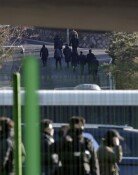S. Korea, U.S. should respond firmly to N. Korean threats and provocations
S. Korea, U.S. should respond firmly to N. Korean threats and provocations
Posted October. 28, 2019 07:34,
Updated October. 28, 2019 07:34
“If the U.S. is hoping to make it through until the end of this year with no issues by highlighting the personal relationship between the U.S. president and the North Korean leader, it is a foolish delusion,” said a statement released on Saturday by Kim Yong Chol, vice chairman of North Korea’s ruling Workers’ Party of Korea, under his position as the president of North Korea’s Korea Asia-Pacific Peace Committee. “Fires can be exchanged at any moment between the two countries,” said Kim. The statement released by Kim Yong Chol four days after North Korea’s First Vice Foreign Minister Kim Kye Gwan released a statement seems to be a pre-warning that North Korea will prepare additional provocations, such as launching submarine-launched ballistic missiles, if there’s no change in Washington’s attitude by the end of this year.
It is unusual for North Korea to put forward the vice chairman of its ruling party who has been excluded from the negotiations with the U.S. since the fallout of the Hanoi summit on February 28. Kim is a hardliner who led South Korean corvette Cheonan sinking in 2010 as then the head of the Reconnaissance General Bureau and threatened to turn South Korea and the U.S. into a sea of fire mentioning the nullification of the ceasefire agreement on Korean Central Television in 2013. The reappearance of Kim is one of the tactics that North Korea is adopting to put pressure on the U.S. to make concessions regarding the denuclearization talks after the breakdown of the U.S.-North Korea working-level talks in Stockholm on October 5. Kim Jong Un’s climbing of Baekdu Mountain on a white horse and ordering the removal of South Korea facilities in Kumgang Mountains, as well as statements to the U.S. by Kim Kye Gwan and Kim Yong Chol seem to be North Korea’s strategic moves draw attention of U.S. President Donald Trump.
Kim Yong Chol’s statement mentioning “the exchange of fires” should not be disregarded as one of the many empty threats by North Korea. A few days ago, North Korea’s propaganda media to South Korea threatened the South Korean government by broadcasting a video titled “Have you already forgotten about Yeonpyeong Island?” indicating the Yeonpyeong Island incident, which was the first attack by North Korea on South Korean territory since the Korean War. North Korea’s back-to-back tough remarks are threats that the tension across the Korean Peninsula could turn extremely volatile at any moment depending on its talks with the U.S. and inter-Korean relations.
However, an official of the South Korean presidential office Cheong Wa Dae just said, “Even though the level of threats has been raised, North Korea expressed its willingness to talk, which is positive.” It is such a complacent reaction, which could lead to a misunderstanding by North Korea. There is no need to deny the possibility of talks to be resumed, however, the overall context should be viewed with the possibility of North Korea’s provocations in mind. It is concerning that the South Korean government’s attitude to turn a blind eye to North Korea’s lousy behavior under the justification to promote peace and reconciliation between the two Koreas will lead to an armed protest or provocation by North Korea.
North Korea has been maintaining its hardline stance since the fallout of the U.S.-North Korea working-level talks in Stockholm, rejecting further negotiations. It is a tactic to introduce the top-down method starting from the two countries’ leaders. Kim Yong Chol’s ludicrous statement is a double-sided strategy to put direct pressure on the U.S. and urge South Korea to push the U.S. further. Under such a circumstance, South Korea and the U.S. should strengthen their cooperation without allowing any error.







